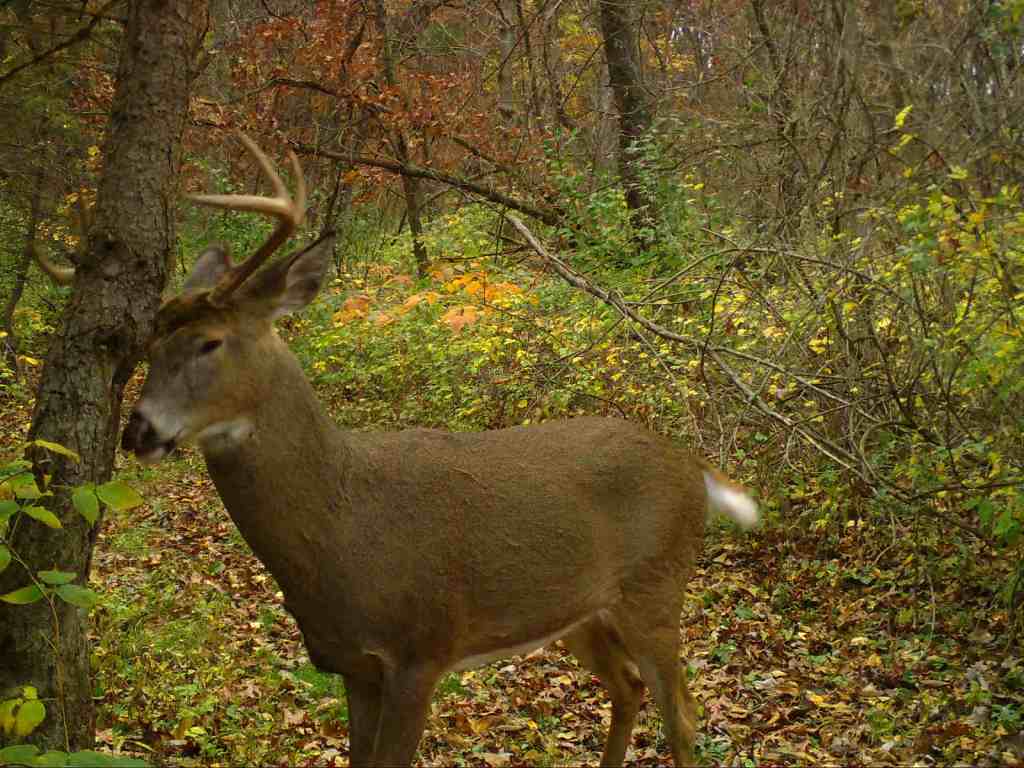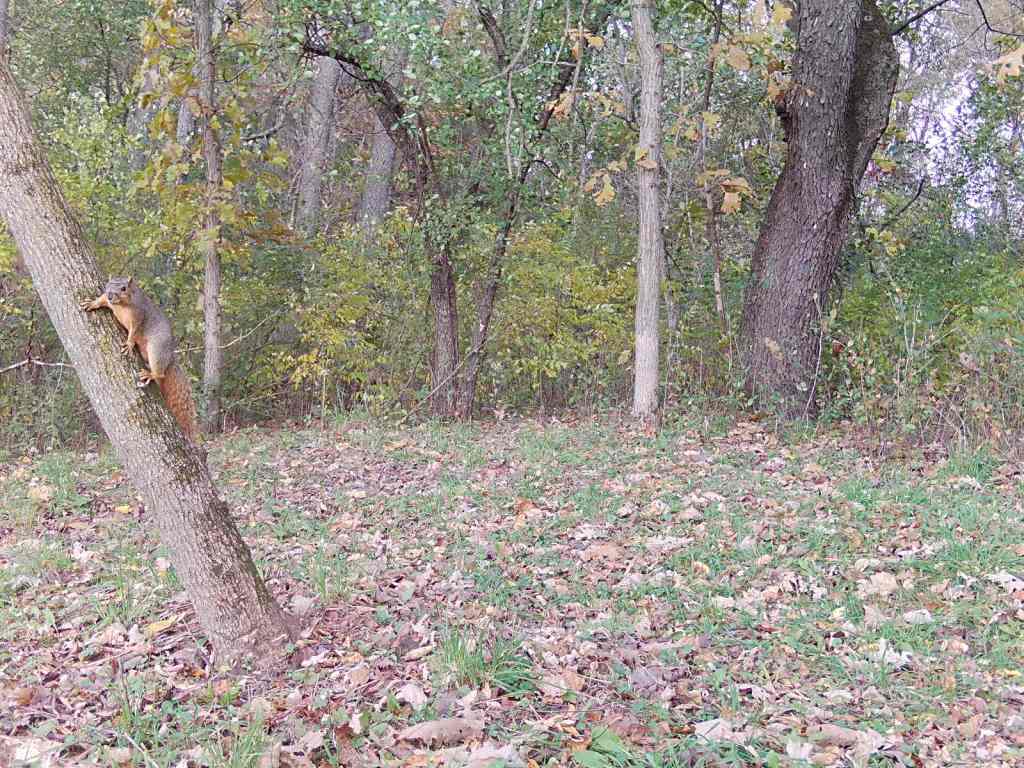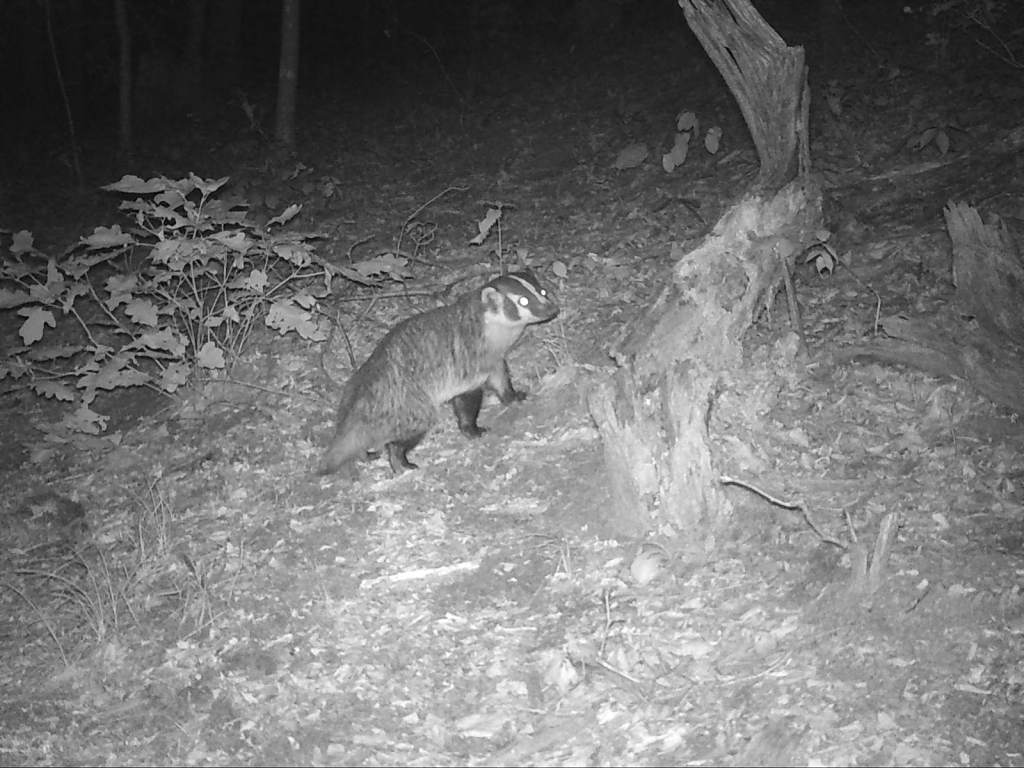March SuperSnap
The March #SuperSnap goes to this buck scratching an itch in Grant County! Male white-tailed deer, also called bucks, will often be observed rubbing their head and antlers on trees in the fall for several reasons. The primary reason is to mark their territory during the mating season or “rut”, which stretches from October through December. Both male and female deer have glands in their foreheads called apocrine glands, which they will rub on trees and branches to mark their territory and communicate with other deer. Bucks are known to mark more often than female deer and the glands are most active in dominant bucks. This buck here is most likely rubbing his forehead gland on the tree in an act to mark his territory for the rutting season. Aside from targeting the apocrine glands in their foreheads, bucks will mark their territory and communicate with other deer in a number of different ways. See if you can spot other behaviors in deer that you think may be them marking their territory!

A huge thanks to Zooniverse participant @Megeth for this #SuperSnap nomination!
Continue classifying photos on Zooniverse and sharing your favorites with #SuperSnap – your submission might just be next month’s featured photo! Check out all the nominations by searching “#SuperSnap” on the Snapshot Wisconsin Talk boards.
Sources:
February SuperSnap
The February #SuperSnap goes to this fox squirrel spotted in Walworth County! There are five species of squirrels that live in Wisconsin, and the fox squirrel is the largest of them all! Their size and coloration usually make them easily distinguishable from the commonly known gray squirrel, as both are found throughout the whole state. The fox squirrel is a rusty-brown color with a yellowish-orange belly and a long buff-colored tail. These vibrant rusty tones are similar to those of the red fox, which is where the fox squirrel gets its name from!

A huge thanks to Zooniverse participant @charleysangel for this #SuperSnap nomination!
Continue classifying photos on Zooniverse and sharing your favorites with #SuperSnap – your submission might just be next month’s featured photo! Check out all the nominations by searching “#SuperSnap” on the Snapshot Wisconsin Talk boards.
Sources:
https://woodlandinfo.org/wp-content/uploads/sites/310/2017/09/G3522.pdf
https://www3.uwsp.edu/biology/VertebrateCollection/Pages/default.aspx
January #SuperSnap
The January #SuperSnap goes to this badger striking a pose in Sauk County! Even though the American badger is Wisconsin’s state mascot, they are quite elusive creatures and rarely make appearances, so it’s always exciting to see one come across Snapshot Wisconsin trail cameras! A shot as clear as this one perfectly showcases their distinct features, like their dark “sideburns”.
Have you ever wondered why the badger is Wisconsin’s state animal? Interestingly, it all dates back to the 1800s and revolves around a rich history of lead mining in Wisconsin. Early colonizers dug tunnels throughout the hillsides of Wisconsin searching for lead. Come winter, many of them were too poor to build homes, so they lived in the mines to make it through the harsh Wisconsin winters – just like badgers! Badgers spend around 90 percent of their time underground through the winter and it can be up to 31 degrees warmer in their dens than the outside air.

A huge thanks to Zooniverse participant @birdeolso for this #SuperSnap nomination!
Continue classifying photos on Zooniverse and sharing your favorites with #SuperSnap – your submission might just be next month’s featured photo! Check out all the nominations by searching “#SuperSnap” on the Snapshot Wisconsin Talk boards.
Sources:
December #SuperSnap
The December #SuperSnap goes to the sandhill crane stretching their wings in Rock County! Have you ever noticed how the feathers of a sandhill crane can range from gray to brown in color? In the spring, the naturally gray bird will “paint” their feathers with mud to camouflage themselves in brown grasses. The sandhill crane is often confused with the great blue heron, especially in flight. When you spot a large bird in the sky, pay close attention to their neck! An outstretched neck will indicate a crane, but a great blue heron will fly with their necks folded back.

A huge thanks to Zooniverse participant @Borealguy for this #SuperSnap nomination.
Continue classifying photos on Zooniverse and sharing your favorites with #SuperSnap – your submission might just be next month’s featured photo! Check out all the nominations by searching “#SuperSnap” on the Snapshot Wisconsin Talk boards.
Sources:
Snapshot Celebrates 50 Zooniverse Seasons!

Snapshot Wisconsin is celebrating its 50th Zooniverse Season this winter! The first Zooniverse season was launched on May 17th, 2016, and has continually brought in thousands of classifiers since then. From China to Mexico, from Russia to Brazil, volunteers have helped Snapshot Wisconsin make more than 9 million classifications!

As we celebrate 50 seasons, we want to take a moment to express our gratitude to all the volunteers who make this project possible. Your work helps Snapshot Wisconsin provide valuable data and research to those making wildlife management decisions at Wisconsin DNR. To all our volunteers, whether you host a camera or help classify photos on Zooniverse, thank you!
In particular, we want to send thanks to our moderators. The success of the Snapshot Zooniverse community would not be where it is today without the generous time and effort put forth by our fantastic team of moderators: @bzeise, @Oregano, @Megeth, @momsabina, @sbreich, and @smeurett.
Our moderators do a terrific job of making the Snapshot Zooniverse community a warm and welcoming place for people across the globe. Much of their work is done by introducing newcomers to Wisconsin wildlife, of which many new classifiers may be seeing for the first time! Additionally, our moderators promote and keep our community standards, which keeps Snapshot Wisconsin Zooniverse a place for anyone and everyone to participate. We are grateful for all you do!
Don’t forget! You and your family and friends can host a Snap-a-thon! Snapshot Wisconsin Snap-a-thons are friendly competitions where a group of people tag animal photos on our crowdsourcing website, Zooniverse, to gather as many points as possible. Who can participate? Anyone familiar with Wisconsin wildlife and with operating a computer can participate. No need to be a wildlife expert: Zooniverse has a built-in field guide to help with more difficult classifications. You can find Snap-a-thon instructions under the ‘activities’ tab here!
November #SuperSnap
The November #SuperSnap goes to the two otters bounding from the waters of Lincoln County! Otters need about 3 square miles to find food but will typically hang out at a few of their favorite spots where the eating is good, such as shorelines, overhanging banks, and areas where fish are found. This member of the Mustelid family is known to be rather playful while they wrestle, chase other otters, and even play capture and release with live prey. These playful behaviors help with coordination and fitting into the social structure of their group.

A huge thanks to Zooniverse participant @MiddleChild for this #SuperSnap nomination.
Continue classifying photos on Zooniverse and sharing your favorites with #SuperSnap – your submission might just be next month’s featured photo! Check out all the nominations by searching “#SuperSnap” on the Snapshot Wisconsin Talk boards.
Sources:
October #SuperSnap
The October #SuperSnap goes to the red fox that was seen preying on a snake in Pierce County! Foxes are fantastic hunters. In fact, they can locate a rustling sound within 1 degree of its exact location using their large, upright ears. When they locate their prey, they will creep low to the ground with their heads outstretched. Then, when they are in the perfect position, they will pounce on their unexpecting prey with their forefeet! Red foxes are omnivores, and they will consume a wide variety of plants and animals which varies with each season.

A huge thanks to Zooniverse participant @Megeth for this #SuperSnap nomination.
Continue classifying photos on Zooniverse and sharing your favorites with #SuperSnap – your submission might just be next month’s featured photo! Check out all the nominations by searching “#SuperSnap” on the Snapshot Wisconsin Talk boards.
Sources:
September #SuperSnap
The September #SuperSnap goes to the curious coyote pup seen in Eau Claire County by a Snapshot Wisconsin trail camera! To prepare for their upcoming litter of 5-7 pups, coyotes will usually repurpose abandoned badger, woodchuck, or skunk burrows for their den sites. Pups are born with short, yellow-brown fur and will be weaned from their mother by the time they are about 8-9 weeks old, at which point the den will be abandoned. They will learn to hunt by following their parents on hunting trips. By the end of the summer, the pups will be ready to go hunting on their own for some of their favorites, such as small rodents, rabbits and sometimes deer!

A huge thanks to Zooniverse participant @citsci-rancho for this #SuperSnap nomination.
Continue classifying photos on Zooniverse and sharing your favorites with #SuperSnap – your submission might just be next month’s featured photo! Check out all the nominations by searching “#SuperSnap” on the Snapshot Wisconsin Talk boards.
Sources:
August #SuperSnap
The August #SuperSnap goes to the doe and fawn spotted together in Sheboygan County! White-tailed deer photos make up 2/3 of animal photos captured by Snapshot Wisconsin trail cameras, which makes them the largest collection of animal photos in the Snapshot Wisconsin database. Each year, the Snapshot Wisconsin dataset is used to track population ratios such as adult sex ratios (doe to buck ratio) and recruitment ratios (fawn to doe ratio) throughout the state. The Snapshot Wisconsin volunteers who host trail cameras and spend many hours classifying photos contribute greatly to these efforts, and we truly appreciate their dedication to the project!

A huge thanks to Zooniverse participant @danborud for this #SuperSnap nomination.
Continue classifying photos on Zooniverse and sharing your favorites with #SuperSnap – your submission might just be next month’s featured photo! Check out all the nominations by searching “#SuperSnap” on the Snapshot Wisconsin Talk boards.
July #SuperSnap
The July #SuperSnap goes to the weasel scurrying off with a prey item in Forest County! In Wisconsin, you can find three different species of weasel: the long-tailed, the short-tailed, and the least weasel. All three species of weasels may turn completely white in the winter, making it challenging to distinguish them. However, the long-tailed and short-tailed weasel will have a black tip on their tail, while the least weasel may only have a few black hairs. All weasels of Wisconsin have similar carnivorous diets, preying on small mammals and birds.

A huge thanks to Zooniverse participant @Megeth for this #SuperSnap nomination.
Continue classifying photos on Zooniverse and sharing your favorites with #SuperSnap – your submission might just be next month’s featured photo! Check out all the nominations by searching “#SuperSnap” on the Snapshot Wisconsin Talk boards.
Sources:

